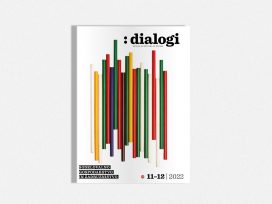The reach of documentary film
During this year’s Ljubljana Documentary Film Festival, Andrej Sprah, Slovenia’s foremost authority on the theory and history of documentary film, writing in the magazine Pogledi, reiterated his thesis that politically engaged creativity in documentary film comes as “a welcome substitute for the decay of investigative political journalism, caused in particular by the corporatization of global media organizations”. On an intuitive level, this hypothesis may seem entirely plausible, but even brief reflection reveals its overreach, especially given that it remains unconfirmed by specific research. On the other hand, a comparison of the two discourses, i.e. those of documentary film and investigative journalism, and the identification of their attributes can tell us a lot about the interchangeability or lack thereof of these related fields. This quickly leads us to a somewhat different conclusion: by the beginning of the twenty-first century, each discourse already has such a long tradition of its own that it is impossible to speak of replacing one with the other. We can therefore argue that rather than being interchangeable, they are complementary fields of endeavor in a symbiotic parallel existence, mutually supporting rather than competing with one another.
The reason why their coexistence is so logical becomes clear once an examination of their characteristics reveals them as two quite different and entirely independent entities. Let’s look at just some of the more obvious ones. The production dimensions of documentary film and journalism cover entirely different time scales: while journalistic discourse, even at its most investigative, demands a rapid response and immediate distribution (in the age of internet media, minutes or even seconds after the original event can be critical), there is in documentary film always a significant time lag, despite the digital revolution; so the final product may be released to the public a year, two years, even three years after the event portrayed. Furthermore, in accordance with their differing narrative qualities, the two forms have different needs in terms of information required, and different ways of presenting this information too: whereas the aim of journalism is to convey the bare facts, documentary film has, from the very outset, a specific aesthetic preoccupation in terms of time scale and narrative, where the latter can unfold in a much looser, even unrestricted, environment. Probably the key problem in the treatment of serious topics in both discourses is the distinction between the presence and the absence of authorship. Journalistic discourse is in this sense somewhat purer, more sincere and altruistic, since its aim is the direct, rapid and unembellished delivery of certain discoveries. It is therefore untainted by what documentary film makes ethically questionable – the fetish of authorship. Right at the outset, documentary film, due to its schizophrenia, which stems from being embedded in the field of art, authorship becomes an ontological problem, in which it is not in fact clear whether the creators of the documentary found themselves in this discourse in order to investigate pressing social issues or so that they can set foot on the red carpets of big festivals. Documentary film, precisely due to this “clutter of authorism”, never achieves the immediacy and approximation of objectivity that journalistic discourse affords.
What is even clearer, and more important, here is this: investigative journalism embedded in television, print and online media has a considerably greater and more direct reach to its audience. The word “considerably” in this sentence is too modest. Documentary films in the vast majority of cases can only dream of having the audiences that television broadcasts have. If we assume that a documentary film in the art cinema network in Slovenia will be viewed by 2000 people (a realistic, even optimistic, figure) and an investigative report broadcast on television has between 200,000 and 250,000 viewers (such, in the opinion of producers, is the viewership, not above the average, of the weekly program Tednik on national television), then here we are already talking about a ratio of 1:100 to the detriment of documentary film. And this is not all – we also need to consider the fact that television discourse addresses the whole of the population, without respect to age, gender, religion or social class, whereas visitors of urban cinema come from a very specific population group, in all likelihood well-educated urban dwellers.
For this very reason both approaches, which more often than not in any case have the same aim, complement one another, as demonstrated best by the film Citizenfour by the American director Laura Poitras. Edward Snowden’s disclosures came out like a bolt from the blue, reaching the public via mass media in June 2013. Filmmaker Laura Poitras – let us not forgot, called upon by Snowden, not on her own initiative – immediately filmed the whistleblower’s hiding in Hong Kong during those days, but the film did not have its world premiere in the USA until October 2014, and it came to Slovenia through regular distribution only in March 2015, 21 months after the original events. For this reason Citizenfour is a different document, though on the same theme: there are no specific disclosures in it, since we already learned about those from the media; however, it shows another side of the story, one that has no place in journalistic broadcasts – the film is a more personal, more philosophical and longer document, without any advertising imperatives. Whereas news of Snowden’s disclosures literally shook the whole world, the documentary film performed its work in a different area – in the world of film, where thanks to its Academy Award the case against the dystopian surveillance of the world population expanded into the otherwise predominantly escapist discourse of Hollywood film. However, both the investigative journalism and the documentary film thus represent a great achievement for each genre and not the competition of one with the other as to which is the more legitimate approach.
Of course, documentary film also has another advantage. Jean-Luc Godard stated decades ago that television, with its sensationalism and market pressures, and with the resultant search for newer and newer news niches, creates oblivion. Documentary film, on the other hand, despite its slower pace, had in the twentieth century created an enviable institution of memory, similar to the role of museums, and offered some of the most impressive and unforgettable documents on the topic of crucial events of the twentieth century. The hopes for social change embodied in documentary film nevertheless rely on a much thinner, more uncertain and unpredictable thread. In an interview at this year’s Berlinale, Joshua Oppenheimer told me a story about how his film The Act of Killing brought about important changes in Indonesian society with regard to the perception of the genocide there, about which there was silence up until recently. The Act of Killing was watched by the first audiences in Indonesia in secret at the time of the world premiere (which took place in August of 2012 in the USA). The editor-in-chief of the most important magazine in the country was also invited to this secret showing of the film. After viewing this overwhelming film, this editor decided, after years of censoring all information about the genocide, that he would break the silence and, to this end, he sent out 16 reporters the very next day to different regions with the task of investigating eyewitness accounts of the murders treated by Oppenheimer’s film. The editor received 1000 pages of boastful statements from former murderers on his desk, and had them printed in a special double issue of the magazine. The issue sold so well that after two editions sold out in quick succession it was printed in book form. As Oppenheimer concluded the story: “That’s a fine example of how you don’t need to move everybody, but if you can move a few of the right people – like that editor, who was a particularly important person to move – then everything else evolves like a kind of avalanche of changes.”
Documentary film with its memory and intellectual breadth on the one hand, and investigative journalism with its rapid response and reach on the other are not rivals: both contribute in important ways towards the same aim – the search for truth. The discourse of truth is the ideal, that eternal archetype which cannot be nullified, and which society must pursue whatever the discourse in which it is realized. Everything else – questions regarding genre, authorship, advertising, funding, whatever secondary clutter arises across the different spheres of its realization – are just unnecessary obstacles in the way of its path.
Published 12 August 2015
Original in Slovenian
Translated by
Dialogi
First published by Dialogi 1-2/2015
Contributed by Dialogi © Matic Majcen / Dialogi / Eurozine
PDF/PRINTNewsletter
Subscribe to know what’s worth thinking about.



